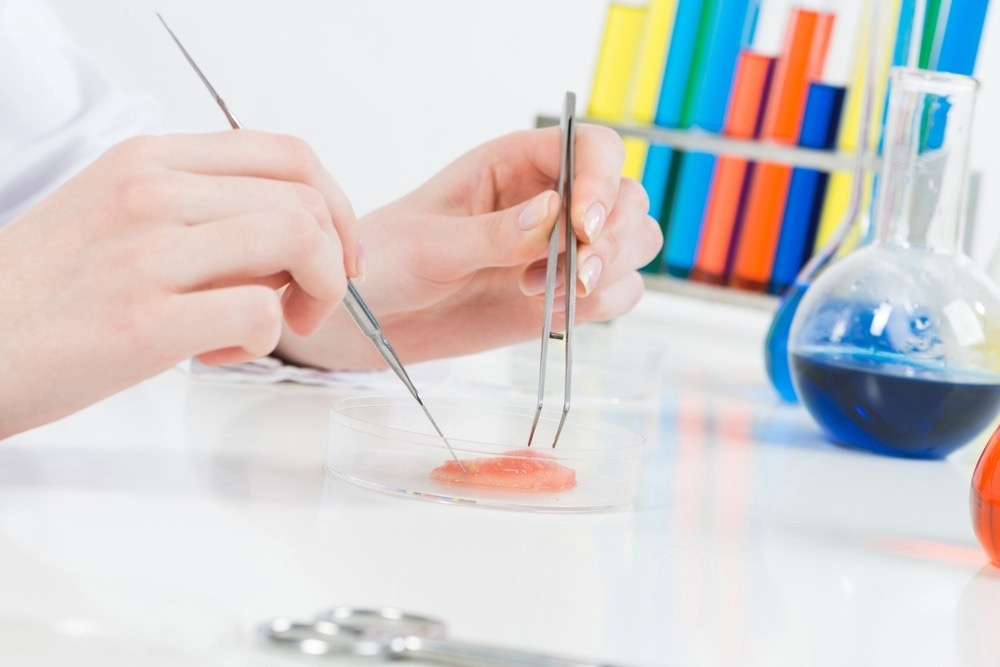Scientists from Australia and India have collaborated on a paper published in the journal Bioprinting, which investigates and reviews the difficulties inherent to fabricating biomaterials with extrusion-based additive manufacturing methods.

Study: Progress and challenges on extrusion based three dimensional (3D) printing of biomaterials Biomaterials e00223 [online, pre-proof] sciencedirect.com. Available at: https://www.sciencedirect.com/science/article/pii/S2405886622000331?via%3Dihub Image Credit: Khakimullin Aleksandr/Shutterstock.com
Additive Manufacturing and the Biomedical Industry
Additive manufacturing, otherwise known as 3D printing, has become a key technology in multiple industrial sectors. In the biomedical industry, additive manufacturing promises to provide researchers with a powerful suite of tools to design products for critical technological advances such as tissue engineering.
This powerful technology has several benefits compared to traditional manufacturing techniques, including the ability to utilize multiple materials, freeform design, and reduce waste. Products with extraordinarily complex external and internal structures can be designed and produced cheaply and efficiently.
Currently, there is intense research into the use of these techniques to manufacture artificial tissues and entire organs for clinical use. The technology itself has advanced rapidly since its inception in the 1980s, with several variants of additive manufacturing techniques developed, such as selective laser sintering, fused deposition modeling, and extrusion-based techniques such as inkjet printing.
Biological structures such as bone and muscular tissue, cartilage, cardiac tissues, vascular tissue, and artificial cardiac valves have been produced in recent years. Whilst there has been progress in realizing whole artificial organs, this is currently beyond the scope of 3D bioprinting technologies.
The Review
Due to the intense research interest in the field of 3D bioprinting currently, there is the need for timely reviews on state-of-the-art technologies, approaches, biomaterials, and future prospects in the biomedical field. This is the aim of the current paper in the journal Bioprinting.
The review paper investigates several aspects of this important field of biomedical science, including cell viability factors and investigating gaps and commonalities in the current body of literature. The study focuses on extrusion-based techniques, as these have shown particular promise in recent years. Furthermore, the review evaluates current technological limitations and explores potential future solutions.
Extrusion-based Bioprinting
Extrusion-based bioprinting is a highly promising additive manufacturing technique for the biomedical industry. It provides operators with benefits such as flexibility, cost efficiency, and the ability to fabricate complex, porous, and highly organized biomimicking structures.
In this technique, a bioink preparation is extruded through a nozzle and deposited layer-by-layer to build functional scaffolds. Bioinks must possess suitable properties such as viscosity and crosslinking capabilities to ensure efficient prints and the structural integrity of final scaffolds. The technique commonly employs hydrogel-based inks.
Several bioinks have been developed in recent years for extrusion-based techniques. These include alginate, silk, gellan gum, hyaluronic acid, collagen, agarose, PEG, PVP, and gelatine-based bioinks.
Preparation
Correct bioprinting preparation is a key element of successful extrusion-based techniques and the fabrication of functional products. CAD design, imaging, materials selection, bioprinting, and correct application are all important parts of the extrusion-based bioprinting workflow.
Parameters such as extrusion pressure and printing speed need to be selected by operators, which strongly depend on factors such as bioink and cell type. Aside from the printer’s parameters, researchers also need to understand the composition and architecture of biological structures.
Main Approaches
In 3D bioprinting, there are three main design approaches: biomimicry, mini tissue building, and autonomous self-assembly. These approaches are also used in related fields such as regenerative medicine and tissue engineering. The choice of approach depends heavily on factors such as the experience of operators, the biological structure of tissues, and bioprinter type.
Recent extrusion-based 3D bioprinting studies have utilized these approaches to produce ever-more-complex tissues. Artificial blood vessels have been manufactured using self-assembly techniques which include living cells. These vascular structures display similar chemical and physical properties to their organic counterparts.
Challenges, Limitations, and Future Prospects
Whilst there has been noteworthy progress in using extrusion-based 3D bioprinting in the medical field, current challenges and limitations have hindered its further development. The extruded filament’s structural integrity is highly impacted by factors such as shear thinning behavior and bioink viscosity.
Another critical issue encountered during these techniques is noddle clogging, which is a frequent problem that significantly impacts the bioprinter’s optimal deposition path. Bioink viscosity and homogeneity play a key role in causing this issue. Uneven flow rates seriously impact bioprinting efficiency. Several factors, both with bioprinters and bioinks, can have a detrimental effect on cell viability.
A key research opportunity in the field is the production of bioinks with cell density values that match the printed tissue. Synthesizing bioinks with varying cell density ranges is a crucial area of research. Innovation in both bioprinting technology and bioink formulation is needed to realize the full potential of extrusion-based bioprinting methods for tissue engineering and regenerative medicine.
Whilst challenges still exist within this field, extrusion-based 3D bioprinting holds immense potential for the future of biomedical research. By reviewing the current state-of-the-art and providing key information on how to overcome current technological limitations, the study in Bioprinting aims to provide future researchers with the tools to make further advances within the field.
More from AZoM: Reflection Electron Microscopy for Crystal Analysis
Further Reading
Vu, M et al. (2022) Progress and challenges on extrusion based three dimensional (3D) printing of biomaterials Biomaterials e00223 [online, pre-proof] sciencedirect.com. Available at: https://www.sciencedirect.com/science/article/pii/S2405886622000331?via%3Dihub
Disclaimer: The views expressed here are those of the author expressed in their private capacity and do not necessarily represent the views of AZoM.com Limited T/A AZoNetwork the owner and operator of this website. This disclaimer forms part of the Terms and conditions of use of this website.